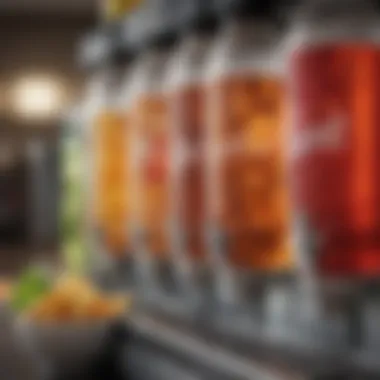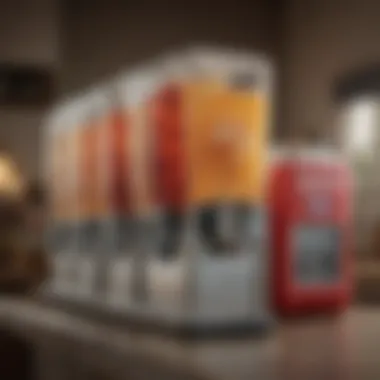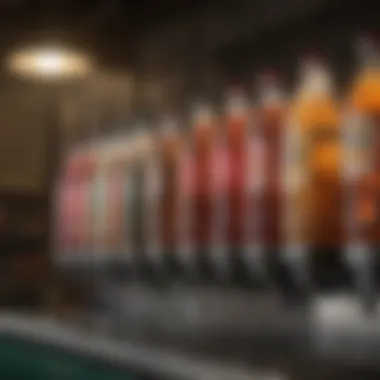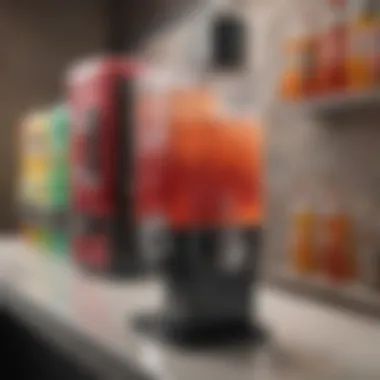The Real Soda Dispenser: A Comprehensive Guide


Intro
Soda dispensers play a vital role in the beverage service sector. Their design and functionality have evolved significantly, reflecting changing consumer preferences and technological advancements. Understanding the mechanics of a soda dispenser can enhance both operational efficiency and customer satisfaction.
This guide delves deep into the world of soda dispensers. We will discuss their historical context, functionality, and various applications in food service. Maintenance and troubleshooting will also be examined, providing practical insights for users.
"Soda dispensers are not just tools; they are integral to the experience of enjoying a beverage, contributing to taste and convenience."
Whether you are a culinary professional or an enthusiast, this text will illuminate the importance of soda dispensers in today’s food service landscape.
The Concept of a Real Soda Dispenser
Understanding the concept of a real soda dispenser is essential for anyone involved in the food service industry or simply curious about beverage management. A soda dispenser is not merely a machine that delivers sugary drinks; it plays a significant role in how beverages are served efficiently, economically, and practically. Its function is rooted in the combination of technology, design, and user interaction that enhances the customer experience.
Definition and Purpose
A soda dispenser is a device designed to serve carbonated drinks, whether it may be soda, juice, or other beverages. It typically consists of a carbonation system, a cooling mechanism, and a delivery apparatus for dispensing the drink. The purpose of these machines is to provide quick access to a variety of beverages while maintaining their desired taste and carbonation. This is crucial for businesses, particularly in high-traffic areas such as restaurants, bars, and events.
The real value of a soda dispenser lies in its ability to improve operational efficiency. By allowing quick and controlled dispensing, it minimizes waste and maximizes productivity. Additionally, modern versions might integrate technology that enables smart ordering or displays promotions, further enhancing their utility.
Brief History of Soda Dispensers
The origin of soda dispensers can be traced back to the late 19th century, coinciding with the rise of carbonated drinks. Early devices were largely manual and required considerable effort to operate. Over time, advancements in technology saw the emergence of more automated solutions, improving the speed and efficiency of service.
The 1950s marked a critical transition period where standalone dispensers began to become widely adopted in fast-food restaurants and cinemas. The familiar button-operated systems of today were introduced during this decade, allowing customers to select their desired drink quickly.
As technology advanced, soda dispensers evolved further. The introduction of computerized systems in the 1990s allowed for precise control of flavor mixes and carbonation levels. Fast forward to today, and we see an integration of digital capabilities that includes smartphone connectivity, inventory management, and even integrated payment systems. This evolution signifies not just a functional improvement but also a reaction to changing consumer preferences and operational needs in the beverage service industry.
"A soda dispenser is more than just a machine; it's a critical component of beverage service that has adapted to the times."
Types of Soda Dispensers
Understanding the different types of soda dispensers is crucial for anyone involved in beverage management or the food service industry. Each type has its unique features, operational mechanics, and advantages. Choosing the right dispenser can enhance service efficiency and customer satisfaction. This section explores three primary types of soda dispensers: traditional soda dispensers, modern automatic dispensers, and eco-friendly soda dispensers.
Traditional Soda Dispensers
Traditional soda dispensers have been a staple in many establishments for decades. These units often require manual operation, where staff fills cups or containers with soft drinks from pre-mixed syrup and carbonated water. The key components include a syrup container, a carbonation tank, and dispensing nozzles.
Benefits of Traditional Dispensers:
- Simplicity: They are generally straightforward to operate and maintain.
- Cost: Lower initial investment compared to more advanced models.
- Customization: Staff can easily adjust ratios of syrup to carbonated water, allowing for tailored drink flavors.
Considerations:
- Labor Intensive: Requires more staff involvement during busy hours.
- Limited Technology: Lacks advanced features like touchscreens or integrated software systems.
Modern Automatic Dispensers
Modern automatic soda dispensers represent the evolution of beverage service. These systems often come equipped with touchscreens and digital interfaces, streamlining operations considerably. They typically utilize advanced carbonation techniques and can dispense multiple beverage choices simultaneously.
Benefits of Modern Dispensers:
- Speed: Can serve drinks much faster, reducing wait times.
- Variety: Often allows for a wider selection of beverages, including flavored and mixed drinks.
- Ease of Use: Designed for minimal training, making it easier for new staff.


Considerations:
- Cost: Higher upfront costs can be a barrier for some businesses.
- Maintenance: Requires specialized knowledge for repairs and upkeep.
Eco-friendly Soda Dispensers
As sustainability becomes a focal point in many industries, eco-friendly soda dispensers emerged. These dispensers focus on reducing waste and ensuring more sustainable practices in beverage service. They often prioritize using less energy and minimizing the use of plastic cups.
Benefits of Eco-friendly Dispensers:
- Reduced Waste: Minimize plastic usage through reusable containers.
- Energy Efficiency: Designed to consume less power than traditional models.
Considerations:
- Availability of Options: Still relatively few options available in the market.
- Public Awareness: Customers may need education on using these machines to ensure optimal use.
Understanding the types of soda dispensers can guide food service businesses in making informed decisions. It allows them to consider factors such as customer preferences, operational efficiency, and environmental impact.
Choosing the right soda dispenser is not just about functionality; it reflects a commitment to quality service and customer satisfaction.
Key Components of a Soda Dispenser
Understanding the key components of a soda dispenser is crucial for anyone involved in beverage service. These components define how the dispenser functions and impact the overall user experience. In this section, we will examine three essential parts: the carbonation system, the cooling mechanism, and the nozzle and delivery system. Each plays a significant role in ensuring that the dispensed soda has the right taste, temperature, and consistency.
Carbonation System
The carbonation system is the heart of any soda dispenser. It is responsible for mixing carbon dioxide with the beverage syrup and water to create the familiar fizz that sodas are known for. There are certain types of carbonation systems, such as traditional cylinder systems and newer technology that uses CO2 extraction methods.
One of the main benefits of an efficient carbonation system is maintaining consistent pressure. This consistency is vital for delivering a uniform bubbly experience across different drinks. Additionally, choosing a high-quality carbonation system can reduce the amount of syrup needed, making it more cost-effective in the long run.
Cooling Mechanism
The cooling mechanism is another vital component that ensures beverages are served at the ideal temperature. A well-functioning cooling system prevents sodas from becoming flat due to temperature fluctuations. This can be achieved through various methods, including compressor systems or thermal systems that utilize refrigerants.
A soda dispenser with an effective cooling mechanism not only enhances customer satisfaction but also extends the product's shelf life. Hot beverages can lead to faster carbonation loss, which impacts the overall freshness of the beverage offered. Therefore, attention should be paid to selecting a dispenser that incorporates up-to-date cooling technologies.
Nozzle and Delivery System
The nozzle and delivery system are crucial for dispensing beverages smoothly and efficiently. This element ensures that a precise amount of soda is dispensed while avoiding wastage. Modern dispensers often come equipped with multi-flavor nozzles, allowing users to switch easily between different soda varieties.
When selecting a soda dispenser, consider the design of the nozzle and the ergonomics of the delivery system. An effective nozzle design can reduce spillage and simplify the cleaning process, which is essential in a fast-paced environment. Proper maintenance of these components is just as important, as clogs and blockages can hinder operations, leading to customer dissatisfaction.
In summary, the carbonation system, cooling mechanism, and nozzle and delivery system are fundamental components that define the performance of a soda dispenser. Their roles in ensuring quality, consistency, and efficiency cannot be underestimated.
How Soda Dispensers Impact Beverage Service
Soda dispensers play a crucial role in the beverage industry. They serve as vital tools that facilitate efficient service in various establishments, from fast-food restaurants to upscale dining. Understanding the impact these dispensers have on beverage operations can elucidate their importance.
Efficiency in Beverage Management
Soda dispensers significantly enhance efficiency in beverage management. They condense the process of serving drinks into a streamlined task. Staff can serve multiple customers quickly, reducing wait times and improving customer satisfaction. When a soda dispenser is integrated into the service environment, it becomes easier to manage beverage varieties and stock levels.
With modern models offering multiple drink choices, staff can swiftly change flavors, catering to customer preferences without delay. Automated systems, in particular, allow for faster serving rates. This efficiency leads to higher turnover rates, which is essential in busy establishments. The result is a smoother workflow for employees while keeping customers happy.
Cost-effectiveness Analysis
Cost-effectiveness is another important aspect of using soda dispensers. They often lead to lower operational costs compared to traditional beverage methods. First, dispensers minimize waste by controlling portion sizes. This not only saves money on ingredients but also promotes responsible drinking habits among customers.
Moreover, the initial investment in a soda dispenser can lead to significant savings in the long term. Functionalities such as syrup-to-water ratios and efficient carbonation systems ensure that drinks are not diluted or over-carbonated. By maintaining product quality, establishments can enhance customer retention.


Choosing the Right Soda Dispenser
Choosing the right soda dispenser is crucial for effective beverage management in both commercial and residential settings. The right dispenser can enhance the efficiency of service, maintain drink quality, and ultimately satisfy customers. A decision based on informed considerations can lead to favorable outcomes.
Factors to Consider
Capacity Requirements
Capacity requirements should be one of the foremost elements to evaluate when selecting a soda dispenser. A device with insufficient capacity may struggle to meet customer demand, leading to frustration. Consideration of this aspect ensures that there is enough liquid in stock for peak times.
A higher capacity is often seen as beneficial for those running busy establishments like restaurants or event venues. Dispensers like the Coca-Cola Freestyle allow for high output without sacrificing flavor variety.
However, too much capacity can lead to wasted product if demand is lower than anticipated. Balancing these factors is key to selecting an appropriate dispenser.
Space Availability
Space availability is another critical factor when choosing a soda dispenser. Restaurants or homes with limited space need compact dispensers without compromising functionality. Choosing a model that fits comfortably in the available area prevents customer congestion and enhances the overall service experience.
Compact models are beneficial, especially in smaller dining areas, but they may not have the same output as larger models. Careful planning of space can yield significant advantages, such as smoother operations and an aesthetically pleasing designation for the dispenser.
Budget Constraints
Budget constraints play a pivotal role in decision-making regarding soda dispensers. Understanding the financial limits allows for better planning and allocation of resources. Features and reliability are often traded against costs; thus, it's wise to assess the best options within a specified budget.
For example, while high-end models offer advanced technology, more affordable options may provide satisfactory performance for lower volumes. Understanding the long-term costs associated with maintenance and product supply can further guide the decision process.
Ultimately, selecting a dispenser involves weighing the characteristics of capacity requirements, space availability, and budget constraints. Each of these factors contributes significantly to the overall functionality of the soda dispenser within a given establishment.
Comparing Features Across Models
When evaluating different soda dispensers, comparing their features across various models can reveal insights into their performance. Not all dispensers are made equal; therefore, knowing how key features such as user interface, flavor options, and energy efficiency differ across models can assist in selecting a dispenser tailored to specific needs. Many modern dispensers offer an intuitive user interface that simplifies operation, while others might boast energy-efficient designs to reduce operating costs. Being informed on these differentiators increases the likelihood of a satisfying investment.
Maintenance of Soda Dispensers
Maintaining soda dispensers is crucial to ensure long-lasting performance and optimal beverage quality. Regular maintenance can prevent common problems, reduce repair costs, and enhance the overall customer experience. This section delves into essential practices that keep dispensers functioning efficiently and effectively in any food service environment.
Routine Maintenance Practices
Implementing routine maintenance practices is vital for the longevity of soda dispensers. Here are key practices to follow:
- Daily Cleaning: Regularly clean the nozzles and drip trays to prevent sticky residues and buildup. This helps to maintain hygiene and ensures clean beverage dispensing.
- Inspection of Components: Check for leaks, loose fittings, or cracks in the system to prevent future malfunctions. Look at the carbonation system for any irregularities.
- Replace CO2 Cylinders: Monitor and replace CO2 cylinders when empty. Not managing CO2 levels can result in flat beverages, impacting customer satisfaction.
- Flushing the System: Regularly flush the soda lines with a cleaning solution to prevent flavor contamination and maintain freshness. This step ensures that flavors do not mix over time.
- Temperature Monitoring: Keep an eye on the temperature around the cooling system. Maintaining an appropriate temperature ensures that beverages stay refreshingly cold.
Routine maintenance not only improves drink quality but also extends the lifespan of the machine and reduces operational downtimes.
Common Issues and Troubleshooting
Soda dispensers can encounter various issues that may hinder their operations. Understanding common problems will aid in quick troubleshooting. Here are some frequent issues:
- Flat Soda: This problem often indicates low CO2 levels. Ensure that the CO2 cylinder is not empty, and check the carbonation system for leaks.
- Leaking Dispenser: If there is liquid pooling under the dispenser, inspect seals, valves, and joints. Tightening loose fittings or replacing worn-out seals usually resolves the issue.
- Temperature Issues: If drinks are being dispensed at a warmer temperature than expected, check the cooling mechanism. Make sure that the refrigerant levels are adequate and that there are no obstructions to airflow.
- Clogged Nozzles: If the flow of soda is weak, nozzles may be clogged. Cleaning or replacing them can restore proper function.
- Inconsistent Dispensing: Variations in drink volume might be caused by problems in the delivery system. Check for airlocks in soda lines and adjust pressures as necessary.
"Routine maintenance not only improves drink quality but also extends the lifespan of the machine and reduces operational downtimes."
Quickly addressing these common issues helps maintain the efficiency of soda dispensers and ensures that customer satisfaction remains high.


Innovative Trends in Soda Dispensing Technology
The landscape of soda dispensing technology is undergoing significant evolution. As consumer preferences shift toward more personalized experiences, the soda dispenser industry responds with innovative solutions. These trends not only enhance user experience but also improve operational efficiency. Understanding these trends is essential for food service professionals aiming to stay competitive in a dynamic market.
Smart Dispenser Technologies
Smart dispenser technologies are at the forefront of this evolution. These systems incorporate advanced analytics, enabling operators to monitor usage patterns in real-time. For instance, sensors track the amount of soda dispensed and predict when supplies may need replenishing. This predictive capability can reduce waste and optimize inventory management.
Furthermore, many smart dispensers offer digital touchscreen interfaces. This feature allows customers to customize their drinks with various flavors and carbonation levels. Engaging customers at this level increases satisfaction and can boost sales.
Importantly, connectivity is a key element of smart dispensers. Many devices now have IoT capabilities, allowing them to communicate with other systems. This may include linking with payment processors or customer loyalty programs. Such integration enhances the overall user experience, making transactions more seamless.
Integration with Ordering Systems
The integration of soda dispensers with ordering systems represents another compelling trend. As businesses adopt more digital solutions, integrating dispensers with Point of Sale (POS) systems becomes necessary. This approach provides real-time data on sales and inventory levels.
By linking dispensers to ordering systems, restaurants can streamline operations. Orders made through mobile apps or kiosks can automatically adjust beverage selections at the dispenser. This reduces wait times and ensures that customers receive their desired drinks promptly.
Additionally, such integration offers businesses the chance to gather customer data. Understanding purchasing behaviors helps tailor offerings and promotions, increasing customer loyalty.
"In the rapidly changing food service industry, adaptability is critical. Innovative dispensing solutions can make or break a customer’s experience."
While these technologies bring numerous advantages, they also present challenges. Maintaining cybersecurity is essential, as systems become more interconnected. A breach could disrupt operations or compromise customer information. Therefore, investing in robust security measures is critical.
Environmental Considerations
Soda dispensers play a pivotal role in beverage service within the food industry. However, their environmental impact is often overlooked. This section delves into the importance of sustainability in soda dispensing and the techniques that can mitigate waste. Understanding these aspects is crucial for businesses looking to align with eco-friendly initiatives while maintaining operational efficiency.
Sustainability in Soda Dispensing
Sustainability in soda dispensing involves the adoption of practices that reduce environmental harm. This can include using energy-efficient devices, reducing waste through smart design, and sourcing materials responsibly. Many modern dispensers focus on minimizing energy consumption. For example, some models are designed to optimize refrigeration, thus lowering energy use without compromising drink quality.
Additionally, companies are increasingly using materials that are recyclable or made from recycled content in dispenser construction. This approach not only reduces waste but also appeals to environmentally conscious consumers. Such efforts reflect a growing commitment within the beverage industry to consider the lifecycle impact of their products. The success of these sustainability practices can lead to operational cost savings and enhance brand reputation.
Waste Reduction Techniques
Reductions in waste can be achieved through several techniques associated with soda dispensers. First, implementing precise portion control technology can minimize excessive use of syrup and carbonation, leading to less waste generated. This technology allows for the exact amount of beverage to be dispensed, avoiding over-pouring.
Moreover, many dispensing units feature self-cleaning capabilities or are designed for easy disassembly. This makes maintenance more efficient and encourages regular upkeep, extending the life of the equipment and reducing the need for replacements.
"Innovative technologies in soda dispensing not only improve efficiency but also contribute actively to waste management and environmental sustainability."
Companies may also adopt operational practices like regular audits to monitor and assess waste production. These evaluations can reveal areas where improvements can be made, further minimizing their environmental footprint. Cultivating an internal culture that prioritizes sustainability will not only aid in waste reduction but also encourage participation from all employees.
Ending
In discussing the real soda dispenser, it is essential to acknowledge its significance not only in the beverage industry but also in the daily lives of consumers. These dispensers have evolved from simple manual systems to sophisticated machines capable of serving a variety of carbonated drinks with precision and efficiency. This article highlights the many aspects of soda dispensers that contribute to their relevance today.
Future of Soda Dispensing
The future of soda dispensing is poised for innovation and transformation. Both the technological advancements and shifting consumer preferences influence this sector. Here are some critical considerations:
- Smart Technologies: Emerging technologies are expected to create smarter dispending systems. These may include touchless interfaces, artificial intelligence for inventory management, and customization features for consumers.
- Sustainability Efforts: As environmental concerns grow, soda dispensers may integrate eco-friendlier options. This includes reducing single-use plastic waste and utilizing more sustainable repair and recycling practices.
- Integration with Mobile Platforms: Future systems might seamlessly connect with mobile apps, allowing customers to order ahead and customize their drinks.
"The evolution of soda dispensers aligns with consumer demand for efficiency and environmental responsibility."
- Health-conscious Options: As more people become health-conscious, there is expected growth in dispensers offering low-sugar or sugar-free options, catering to diverse diet preferences.
The evolving landscape of soda dispensers reflects broader trends in technology, health, and environment, ensuring they remain relevant in the ever-shifting marketplace.















